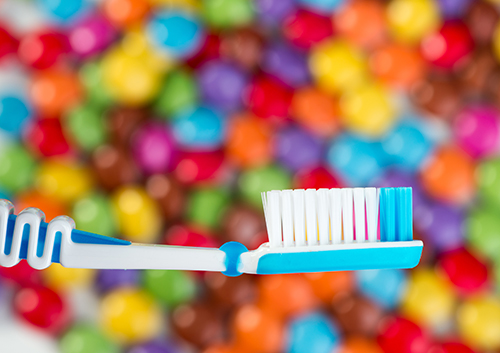The Evolution of the Toothbrush
February 21st, 2017

Oral hygiene has always been an important part of maintaining overall health. For thousands of years, humans have found ways to keep their teeth and mouths clean. According to the American Dental Association (ADA), “early forms of the toothbrush have existed for nearly 5,000 years.” But what exactly did the first toothbrush look like?
Toothbrush Timeline
With help from The Library of Congress, Drs. Angela Paros, Amer Atassi, Eric Young, Alexander Katsnelson and our team have compiled a timeline with some interesting details about the evolution of the toothbrush:
- 3000 BC – Perhaps the earliest form of the toothbrush, the “chew stick” was used by Ancient civilizations. People would rub this thin twig with a frayed end against their teeth to remove food and plaque.
- 1498 – The bristle toothbrush was invented in China and had many similarities to the toothbrushes used today. These devices were made by attaching the stiff, coarse hairs from the back of a hog’s neck to handles that were typically made from bone or bamboo.
- 1938 – Signaling the end of the boar bristle, Dupont de Nemours introduced nylon bristles, and Americans welcomed Doctor West’s Miracle Toothbrush, the first nylon toothbrush.
- 1960 – The Squibb Company introduced Broxodent, one of the first electric toothbrushes, to the American market.
Toothbrushes Today
Today, there are many brands of toothbrushes that often advertise different benefits. The variety of options may seem overwhelming, but the most important thing is for you to find a toothbrush that you like and find easy to use.
The ADA recommends that you choose a toothbrush that fits comfortably and allows you to effectively reach all areas of your mouth. Whether you decide to use a manual or a powered toothbrush, make sure that you thoroughly clean all surfaces of your teeth twice a day.
Society has come a long way since the days of the chew stick, but one thing that remains the same is the importance of consistent and effective personal oral hygiene.
Choose Chocolate on Valentine's Day
February 14th, 2017

From a student handing out sweets for her classmates to an older married couple exchanging boxes of candy, Valentine’s Day is the time of year when people like to show affection by gifting sugary treats to their loved ones. Whether you’re on the giving or receiving end of Valentine’s Day candy, you can celebrate the holiday in a healthier way by making dark chocolate your confection of choice.
Contribute to Your Health
According to the Cleveland Clinic, studies have shown that the cocoa beans used to make chocolate contain flavonoids, which can help protect the body against damage from various toxins. Flavonoids may also help lower blood pressure and improve blood flow to the heart and the brain. Dark chocolates typically contain a higher amount of flavonoids than other types, making them a great choice for chocolate lovers. However, you should keep in mind that many companies produce chocolate that is so heavily processed that the flavonoids are largely eliminated. Your best bet is to look for high-quality dark chocolates and cocoa powders that have undergone minimal processing.
Protect Against Cavities
If you think there’s no way candy could ever be beneficial for your teeth, think again. The Texas A&M Health Science Center has reported that the tannins present in cocoa beans may actually help prevent cavities by interfering with bacteria’s harmful interaction with teeth. Just like with flavonoids, tannins have been found to be present more often in dark chocolates, rather than milk chocolates, giving you another great reason to choose the richer, sweet varieties.
Avoid a Sticky Situation
One more benefit of choosing chocolate over other candies is that it is less likely to get stuck in the crevices and spaces between teeth. Gooey sweets like taffy can stay lodged in the mouth for longer periods of time, putting you at a greater risk for developing cavities. When you choose your chocolate, be sure to avoid types that also contain sticky ingredients like caramel or marshmallow, and instead opt for the plain varieties.
Remember that the health benefits you can receive from dark chocolate are largely based on eating the candy in moderation. With that being said, it’s easy to make this delicious and health conscious switch when you’re out shopping for your sweetheart, friends, loved ones, and yourself. Have fun satisfying your sweet tooth this year and Happy Valentine’s Day from all of us at High Point Dental Group!
Five Easy Ways to Prevent Gum Disease
February 7th, 2017

Gum disease can be painful and lead to missing teeth if you don’t treat it properly. However, there are plenty of things you can do to lower your risk of getting gingivitis and periodontitis. Here are five easy ways to prevent gum disease.
1. Brush your teeth.
Basic oral hygiene is the first line of defense against gum disease. The reason is due to the way gum disease progresses. There are bacteria in your mouth that produce a sticky substance called plaque. Plaque can build up and form tartar. Together, plaque and tartar lead to the painful symptoms of gum disease. You can remove plaque from your teeth with regular careful brushing, but you can’t remove the tartar with your regular toothbrush. So, it’s best to brush at least twice a day, or after each meal, to continuously remove plaque from your teeth. Also floss your teeth and use mouthwash to prevent the bacteria in your mouth from having anything to eat.
2. Stop smoking.
Smoking is a major risk factor for gum disease. Your risk of getting gum disease if you’re not a smoker is one-seventh the risk of someone who does use tobacco. It’s also worth quitting smoking even once you do get gum disease, since treatment is less effective when you’re using tobacco.
3. Eat right.
Gingivitis is a bacterial infection, and a strong immune system helps fight it. Many nutrients are essential for a well-functioning immune system. For example, eat plenty of fruits and vegetables, such as citrus fruits, broccoli, and strawberries, for their vitamin C, which is an antioxidant. Vitamin E, which is another antioxidant, is in nuts, plant-based oils, and wheat germ.
4. Visit our Romeoville, IL office regularly.
You might not be able to detect that you have gum disease, even if you watch for symptoms. Drs. Angela Paros, Amer Atassi, Eric Young, Alexander Katsnelson can detect signs of gum disease before you do.
5. Catch it early.
Since only we can remove tartar once it forms, keep watching for signs of gum disease. They include sensitivity while brushing your teeth or when eating hot, cold, or sugary foods, painful or bleeding gums, and loose teeth. You might also notice that you have bad breath for no reason. Make an appointment with at our Romeoville, IL office if you think you may have gum disease.
Alleviate Tooth Sensitivity
January 31st, 2017

If a sip of ice water, spoonful of ice cream, or piping hot latte is enough to send shivers up your spine from tooth sensitivity, be assured you are not alone. It’s estimated that as many as one in eight adults suffers from tooth sensitivity.
What causes sensitive teeth?
Some of the causes of tooth sensitivity include brushing too hard, a cracked tooth, receding gums, periodontal disease, tooth bleaching, or other conditions that expose the sensitive roots of your teeth. For example, brushing too aggressively can injure your gums, and lead to exposed roots and tooth sensitivity.
When the enamel on the outside of the tooth or tissue located between the teeth breaks down or wears away, nerves inside the tooth trigger sensitive teeth that are particularly noticeable when you drink or eat anything hot or cold.
How to alleviate tooth sensitivity
Fortunately, there are a number of things you can do, both at home and at the dental office, to reduce the discomfort of sensitive teeth. Brushing with desensitizing toothpaste is one of the ways to reduce tooth sensitivity: it works well for many patients, and is typically the first course of action.
- Brush with toothpaste specifically designed for sensitive teeth.
- Change the way you brush by using a soft toothbrush and not brushing too aggressively.
- Avoid brushing teeth after consuming acidic foods and beverages, like orange juice and pickles.
- Drink water or milk after eating or drinking acidic foods or beverages.
- Sip through a straw when you drink acidic beverages.
- Wear a mouthguard at night to prevent teeth grinding that wears down teeth.
- Ask Drs. Angela Paros, Amer Atassi, Eric Young, Alexander Katsnelson about fluoride dental treatments or plastic resin.
For moderate-to-serious cases of tooth sensitivity, more invasive professional dental treatments are available. These include a bonding agent designed to seal/cover the exposed root, obtaining new gum tissue through graft (for receding gums), fillings, crowns, inlays, or bonding. When tooth sensitivity is persistent and results in hypersensitivity, endodontic treatment in the form of root canal may be recommended.
To learn more about tooth sensitivity, or to schedule an appointment with Drs. Angela Paros, Amer Atassi, Eric Young, Alexander Katsnelson, please give us a call at our convenient Romeoville, IL office!






